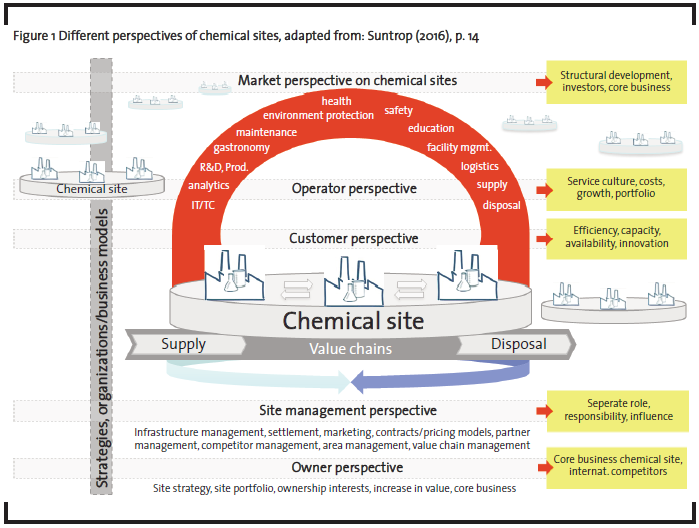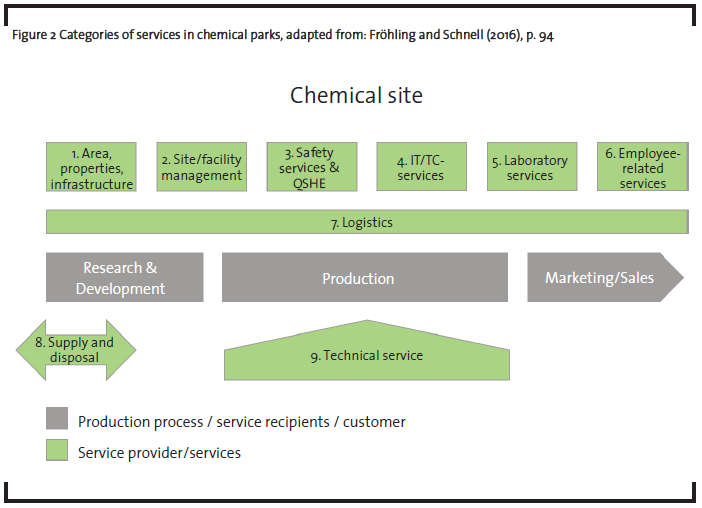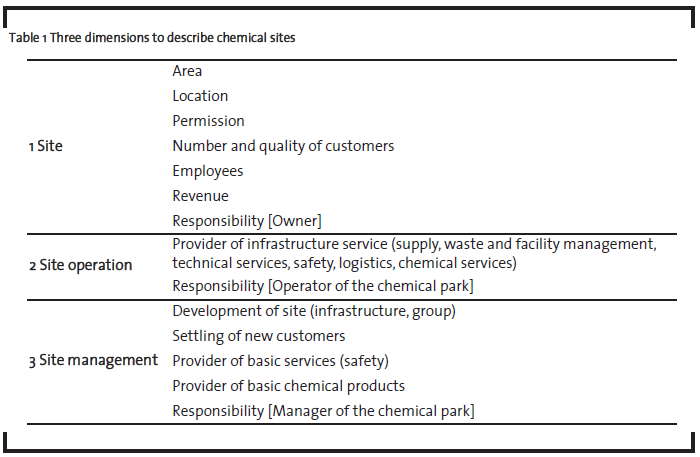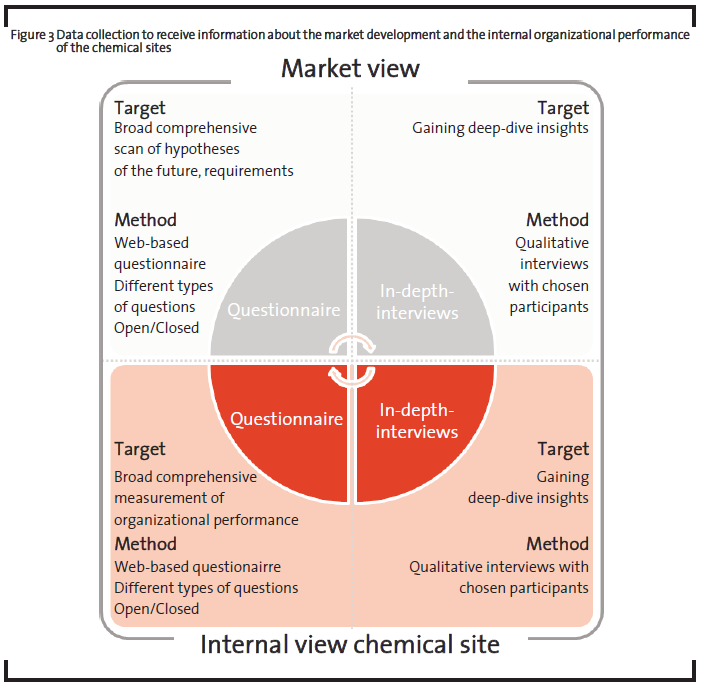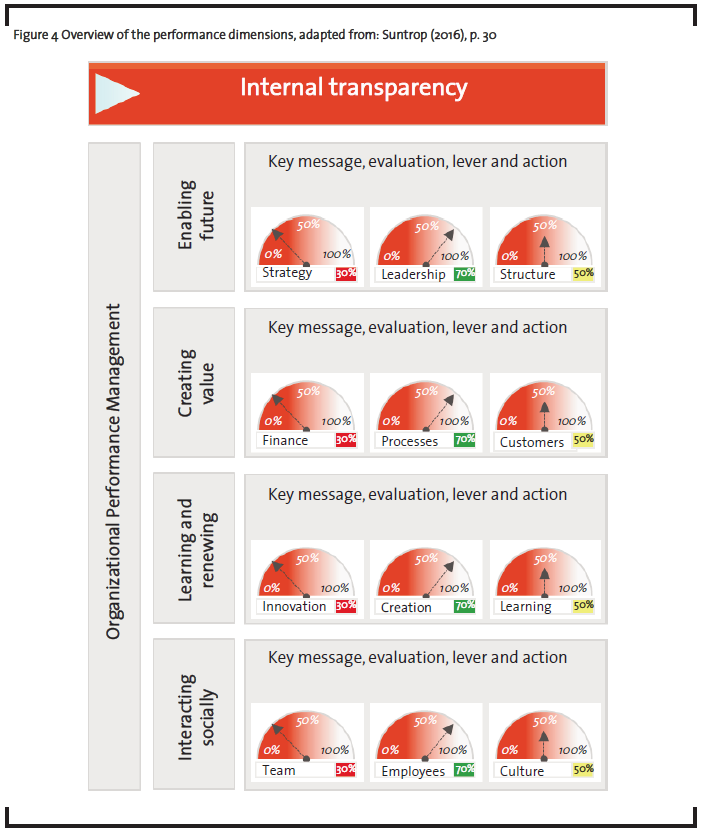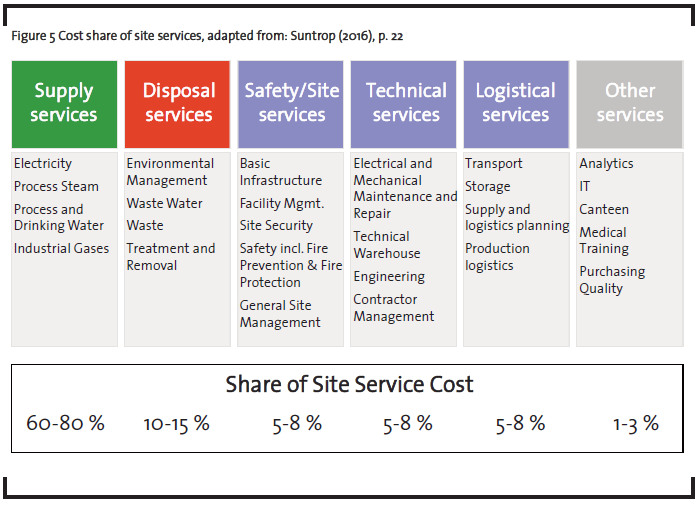The future of German chemical sites: Potential pathways and organizational readiness (Introduction of a study design)
Chemical sites are an integral part of the chemical industry in Germany. Therefore, it is obvious that the development from diversified to more specialized chemical companies will also lead to rising challenges for the chemical siting sector. Furthermore, chemical sites need to react to changes in the environment of chemical companies, such as the relocation of supply chains or intensifying EU regulations. As changes in the chemical industry require the adaptation of chemical sites, this article presents a study design to assess the status quo and the future challenges chemical sites will need to confront.
1 Introduction
The chemical industry is one of the most important sectors and it has a long tradition in Germany. But since the 1990s the structure of the chemical industry has changed considerably. About 20 years ago, the market was dominated by a few big diversified companies.
Today, most of the companies are more specialized and smaller in terms of sales and employees. In 2006 about 93 % of chemical companies were small and medium-sized enterprises and this trend continues. Often those smaller chemical companies arose as units branching off from diversified companies in order to concentrate on core processes. A consequence of the concentration on core processes is the increasing outsourcing of infrastructure services and other site services to subsidiaries or external service providers. The multiplicity of interests at the chemical site and its many interfaces must be considered (Wildemann, 2016, Wildemann, 2009), and is presented in more detail in chapter 2.1. Today, the chemical industry in Europe and especially in Germany faces many different challenges. The relocation of supply chains to regions with cheaper costs for raw materials, the increasing investments in regions with higher economic growth and the mounting regulations for the chemical industry in the EU are just some examples of challenges faced by the chemical industry (Vormann, 2016). Nevertheless, the chemical industry in Germany has one decisive competitive advantage in comparison to other regions: chemical sites. Using common supply and disposal structures, as well as purchasing resources and intermediates in the composite structure of chemical sites, generates synergies for the chemical companies located at the site. This offers a significant competitive advantage to chemical companies. Small, mediumsized and big chemical companies can focus on their core competencies, while the site and infrastructure services are offered by specialized service providers (Wildemann, 2016; Wildemann, 2013). Due to the changes of the structure of the chemical industry, chemical sites also changed profoundly over the past 15 years. They evolved from internal organization of the site to professionalized service providers. Today, they are a branch of industry in their own right and specialized operators and managers of chemical sites have become critical to the success of the industry as a whole. Chemical sites nowadays have separate conferences and working groups at VCI specifically for their own branch of industry.
Besides the challenges faced by the chemical industry, the chemical sites industry has its own challenges and threats, such as being an innovative and customer-oriented service company with core competencies in management of change and complexity. Different business models and the transfer of business models to other chemical sites are just some of the challenges chemical sites are currently facing (Suntrop, 2016). Following this introduction, section 2 provides a definition of chemical sites, taking different perspectives into account. The difference between traditional industrial parks and chemical sites is presented, as well as site services and the future trends of the industry of chemical sites. Section 3 gives an overview of the study as well as the research focus: chemical sites. Also, the research design is presented in detail. For the assessment of the future development of chemical sites in section 4, five hypotheses are developed, which are based on key driving forces affecting chemical sites. In addition, twelve internal performance dimensions are presented, addressing different facets of chemical sites. Furthermore, the cost structure of chemical sites is differentiated. The three aspects, hypothesis, internal performance and site service costs, are the basis for the questionnaire design. A future outlook from the study results and the benefits arising for different stakeholder groups is given in section 5.
2 Chemical sites at a glance
2.1 Different perspectives on chemical sites
Since chemical sites bring together different stakeholder groups it is essential to describe the perspectives in more detail. In general, five perspectives need to be considered: Market of chemical sites, operators, customers, site managers and owners.
Figure 1 shows the different perspectives and their respective interests, requirements as well as their strategic challenges.
The market perspective on chemical sites as a whole focuses especially on structural development and the attraction of investors.
The customers, meaning the chemical companies at the site, buy the site services. They want to safeguard their management, marketing, research and production tasks as well as their inbound and outbound supply chains. They therefore deal with important matters of efficiency, capacity, availability and innovation.
The operator of the chemical site offers diverse site services (see figure 2 for examples). This is why establishing a service culture, having a clear service portfolio as well as low costs to guarantee an attractive price level are essential issues for the operator. In addition, the operator is interested in stability and the growth of his service business.
The manager of the chemical site bears the responsibility for the attractiveness and competitiveness of the chemical site. He has various tasks:
infrastructure management, settlement, marketing, contract and pricing models, partner management, competitor management, area management and value chain management.
The owner of the chemical park is responsible for the site strategy, site portfolio, ownership interests and increase in value – so he is interested in high capacity utilization and in the international competitiveness of the site (Suntrop, 2016).
Due to interlinkages between these different perspectives, many ideal types and visionary organizational structures as well as business models may arise. Chemical sites are applying a diverse set of business models to satisfy respective stakeholder groups. Considering the need for the integration of these different perspectives, chemical sites must develop systematic tools and measures to fulfil the multiple requirements of their stakeholders (Suntrop, 2016).
2.2 Definition of chemical sites
In order to consolidate the perspectives introduced above, a comprehensive definition of chemical sites is presented. Therefore, a chemical site is primarily defined according to the following criteria:
- A chemical site is a geographical cluster of legally independent chemical suppliers and chemical/industrial consumers (chemical industry in the following value-added stages: petro, basic, specialty and agro chemicals).
- At chemical sites, hazardous and non-hazardous substances are produced, researched and marketed from predominantly limited-access locations.
- Multiple services such as the supply of media, disposal of waste and wastewater, maintenance, logistics, basic infrastructure, facility management, health-, safety-, environmental- and quality-management, safety, analytics, education, social services and administration ensure the effective and efficient processing of supply chains located at the chemical site.
- The manager of the chemical site controls the high and sustainable market attractiveness of the site.
- Due to the effective and efficient processing of supply chains the owner of the chemical site can secure the capital employed for infrastructure and areas of the chemical site in the long run.
- All this happens according to each individual history of development at each chemical site (owner, products, contaminated waste, location, network) (Suntrop, 2016).
2.3 The difference between traditional industrial parks and chemical sites
The main difference between traditional industrial parks and chemical sites is that chemical sites are connected at all levels. The companies that are located on the chemical site make it a functional and logistic entity. There are synergies and network effects that are a unique feature of chemical sites (Grigat, 2016).
The formation of chemical sites has been a real success model for Germany as a business location. Nevertheless, professionalization of services, strict segregation of the core business and the strategic orientation of the different chemical sites indicate potential for improvement in the future. Small chemical sites in particular have only just started to work with external companies and open up to the competitive environment. They lag behind in developing themselves into professional and competitive sites (Wildemann, 2016).
2.4 Site services – a market alongside chemical sites
A service industry has arisen around chemical and industrial sites. This industry is a multimillion dollar market in a major state of flux. Figure 2 shows the main areas of service offered to companies.
Site services are diverse. Everything that does not directly contribute to the production of intermediate or end products can be classed as (industrial site) services. Because of the wide range of site services, services are clustered into nine categories (please also see figure 2):
- letting and leasing of area, properties and infrastructure,
- services concerning site / facility management,
- safety services and QSHE (quality, safety, health, environment),
- IT and TC (telecommunication) services,
- laboratory services,
- employee-related services,
- logistical services,
- supply and disposal services and
- technical services.
Only the letting and leasing of area, properties and infrastructure, most supply and disposal services, and some safety services are so-called sitedependent services. Fundamentally, all other services can be offered site-independently.
Since service providers at chemical sites are competing with other companies in this growing market it is vitally important to apply the right business models.
From diversified full-line suppliers to highly specialized industrial service providers and from providers that are not mobile to ones that are – everything can be found.
Some service providers are still bound to their customers due to their ownership structure.
One current trend is the backward integration of the service organizations into the companies, e.g. Dow, Evonik and Lanxess (Fröhling and Schnell, 2016).
Different levers can be used to optimize site services: Strategic reviews regarding the in- or outsourcing of services, active management of demand and an optimized management of the overall process, which develops from an isolated view to a broad perspective. Optimization of site services can lead to cost reduction and an improvement of the competitive situation (Hofmann and Michel, 2016).
What should be pursued in addition to this is a fully automated, digital chemical site that has highly integrated energy and material cycles and good transport connections.
2.5 The chemical industry is changing
Specialization, staggered supply chains, multiregional global competition, turnaround in energy policy – these are just a few examples that drive changes in the chemical industry. Due to a lack of natural resources in Germany and Europe only a specialization of technical and highly valuable products make the decisive difference. The high-performance infrastructure of chemical sites offers a good prerequisite for enabling innovative chemical products and processes to be successful in the world market. However, the industry has to help shape these changes that begin at the grassroots (Mathies, 2016).
Therefore, the following section presents a study design which aims to outline a picture of the future of the market of chemical sites; which requirements chemical sites have to meet in the future and how their actual performance can be measured today.
3 Study design
3.1 Overview of the study
Our study focuses on the industry of chemical sites located in Germany. As such, the market of chemical sites is surveyed with the intention of creating transparency and supporting the future development of the industry and the market players in responding to upcoming challenges. As a starting point for the study, chemical sites are described in more detail. Secondly, the future of chemical sites is described, and thirdly, the performance of chemical sites is analyzed by applying 12 identified performance indicators. Analysis of the study results will provide the additional benefits of enabling identification of points where there is need for action, possible action strategies, and market potential.
The study aims to answer the following research questions:
- What is the future development of the industry of chemical sites?
- What requirements will chemical sites have to meet in the future?
- What is the degree of fulfillment of those requirements today?
- What is the overall performance of chemical sites?
- What are the challenges faced by the market of chemical sites?
3.2 The research focus: chemical sites
As already mentioned, this study focuses upon chemical sites. In the following, the research object is further characterized to set a clear scope for our study:
- Region: Germany
- Industry: Sites that focus on the chemical and processing industry.
- Site structure: Multi-user sites are the object of the study, where several legally independent companies are located on each site. So, different manufacturing companies use the infrastructure jointly. It might be possible to transfer the operation of the site to one institutional unit.
- Operator of the chemical site: The provider for at least one operator service (e.g. supply) is organizationally defined.
- Manager of the chemical site: Management responsibility for site development and business is identified according to all stakeholders.
3.3 Presentation of the research design
The first step of the study is the collection and consolidation of information about the participating chemical sites. In general, the information is differentiated according to three dimensions comprising a set of criteria.
The first dimension “Site” mainly focuses on information about the site itself by collecting predominant facts like the area in which the site is operating, the number of customers and employees or the generated revenue.
The second dimension “Site operations” is more focused on the services provided at the site. Therefore, in particular qualitative information about, for example, the supply, waste and facility management, technical services, as well as the chemical services, are analyzed.
The third dimension “Site management” explains the competitive and sustainable development of the chemical site in more detail by collecting, for example, information about the settling of new customers.
A detailed overview of the research criteria is also shown in table 1.
The second step of the study aims to conduct quantitative and qualitative data collection from different site stakeholders. The starting point is the identification of driving forces and requirements affecting chemical sites and their future development. This information forms the basis to develop appropriate hypotheses on relevant topics, which are the focus of the data collection. Furthermore, twelve performance indicators are used to assess the internal performance of the organization (see the following section 4).
Basically, the study is conducted in a two-step approach (see figure 3). First, managing directors of chemical companies at the site, managing directors of chemical site service providers, heads of site development and site management, project developers of chemical sites, heads of business development at the site, shareholders of the site and external experts will be asked to participate in an online survey. The results will show the perspective of the participants on the future development as well as potential requirements. Furthermore, the developed hypotheses can be verified or falsified. In the online survey, the participants will also assess the internal performance of the sites by answering questions on the twelve performance indicators (see figure 4).
Second, in-depth interviews will be conducted with some of the participants to receive more qualitative statements and deep-dive insights about the upcoming challenges of the future. In this way, the results from the first step can be verified and they can also be researched in more detail.
4. Hypotheses development
4.1 Driving forces for future development
The general definition of the chemical site as well as the different stakeholder groups were presented in section 2. The identification of driving forces is partly based on this definition and also on current global trends in the chemical industry. In total, six driving forces are presented and the influence on chemical sites is explained in more detail.
Internationalization
Global chemical production has an average growth of 3.4 % in the forecasting horizon from 2015/16 till 2030. But 60 % of the total growth applies to China, while the average growth of German chemical production is only 1.5 % (VCI, 2016). The internationalization of chemical companies is therefore still of great importance. Chemical companies can benefit from higher growth rates abroad.
Nowadays, most German chemical companies are already operating on a global level and the trend to exploit markets in emerging countries is still ongoing. Therefore, internationalization is one factor that could potentially affect the future development of chemical sites.
Competitive environment
The literature on the chemical industry assumes that between 2015 and 2035 the growth of the European industry will lag far behind in comparison to the growth of the global chemical industry (Schulz et al., 2012; Keller et al., 2015). On the one hand this emphasizes that the competition will increase and on the other hand it gives a first indication of the necessity for chemical sites to adapt to those changes.
The cost structure is still one decisive factor influencing a consumers’ decision. Therefore, chemical companies need to realign their efficiency management by using so far unused capacities.
Customer demands
Considering the current trends in the chemical industry, service providers at chemical sites are facing various challenges. The digitalization of chemical sites, for example, challenges the service providers to implement new services to meet the changing demands. The cost needs to be controlled at the same time as the product portfolio is extended.
Ownership
The owner of a chemical site is not necessarily the service provider. There are different options to organize the ownership. First, the biggest user is the sole owner of the site (e.g. Chempark, Industriepark Walsrode, Heraeus, Evonik Marl/Wolfgang). Second, there are several producers operating at the site, and they have shared ownership (e.g. Höchst, Gendorf, Knapsack, Wiesbaden, Chemipark Leuna). Third, the chemical site is assigned to an external investor (e.g. ThyssenKrupp-Xervon at Köln-Merkenich, Münchsmünster) (Pruys, 2011). The leadership as well as the structure of the sites vary slightly according to the ownership of the chemical site.
Innovation capability
One aspect important for the attraction of customers to chemical sites is the interdisciplinary and innovative environment. Chemical sites provide companies with different specializations the opportunity to establish various forms of cooperation (VCI., 2013; Leker and Golembiewski, 2015). As such, corporations can increase their innovation performance by conducting research across industries and disciplines.
4.2 Hypotheses
The previous two sections presented and set the foundation on which the following five hypotheses are built:
Hypothesis 1:
As production sites of chemical companies have partly relocated to Asian countries and overall internationalization continues, the management of chemical sites must consider the opportunity of offering services abroad. Thus, the service providers of chemical sites will need to expand their businesses globally to stay competitive in the changing environment, to exploit emerging markets and to benefit from international growth. As such, the set-up of the strategy and the structure of chemical sites are decisive for their future development.
Hypothesis 2:
The cost and efficiency pressures on service providers at chemical sites will steadily increase. Therefore, there is a need to create more cost transparency throughout the industry of chemical sites and work on progressive cost reduction. This means that chemical sites need to analyze their cost structure and adjust it to stay competitive.
Hypothesis 3:
The competition between chemical sites for attracting new industrial settlements will increase. Hence, chemical sites have to align their business models so that they have a consistent focus.
Hypothesis 4:
The ownership of the chemical site will have an effect on the strategy pursued and therefore on future development. Being simultaneously both producer (user/ customer) and owner of a chemical site is an interrelated doubling of roles. This impedes the entrepreneurial responsibility and the business alignment of chemical sites.
A clear positioning as an internal service center would often be more consistent if the core business of the owner remains producing chemistry. On the other hand, the operation of the site could be the core competence of the owner, with the development of the site and the increase of its value being the main aims. The positioning of the owner therefore needs to be clearly aligned.
Hypothesis 5:
The innovation culture of chemical sites will have a decisive impact on the attraction of stakeholder groups (e.g. customers and investors). Thus, chemical sites need to set a clear strategic focus, for example by also attracting downstream industries. They have to ease research efforts across different industries and disciplines.
4.3 Internal performance
Measuring the internal performance and creating transparency of site service costs will make it possible to assess how competitive and futureoriented chemical sites already are.
4.3.1 Performance dimensions
To measure the internal performance of an organization, the tool presented in figure 4 is used. This tool represents a systemic and constructivist view of organizations, meaning that organizations are seen from different perspectives. It is shaped by change management and strategy management concepts as well as by practical experiences. This tool can also be used for discussions about cooperation and acquisitions or as a guide for company expansion and restructuration. It consists of twelve indicators.
The twelve performance indicators are shown in figure 4. Furthermore, the indicators are assigned to four subordinate topics: Enabling future, Creating value, Learning and renewing, Interacting socially. The presented dimensions ensure the performance of an organization in the long-term and are therefore important for the future development of chemical sites. The performance indicators are measured in percentages. A performance indicator that is valued at 100 % works perfectly, while a performance indicator that is valued at 0 % is very poor. All indicators are measured in the same unit so that the total performance can be calculated.
The performance indicators show the fields in which the chemical site is already well-positioned and the fields in which actions are required in order to meet previously identified future challenges.
The first dimension Enabling future comprises the performance indicators: Strategy, Leadership and Structure. By assessing the status quo of those three indicators the participants draw a picture of the current capability of the organization to be future-proof.
The second dimension Creating value mainly focuses on: Finance, Processes and Customers. When assessed by the participants, those indicators reveal how well the organization creates value and meet the needs of its customers.
The third dimension Learning and renewing assesses the performance in the fields: Innovation, Creation and Learning. These indicators evaluate the capabilities of the organization to adapt to its environment, to develop and to renew itself.
The fourth dimension Interacting socially deals with the different levels of social relationships as well as working conditions within the organization: Team, Employees and Culture. These indicators focus on communication and individual development (Muhler and Suntrop, 2016).
4.3.2 Transparency of site service costs
Another and additional claim of the study is a comparison of site service costs at different chemical sites. This is to increase the transparency of the cost structure at each chemical site and to give sites the opportunity to see how competitive they are when they compare their cost structure with other sites. To keep current customers and to attract new ones it is crucial to know whether the service costs are more or less expensive than at other sites.
Figure 5 shows the cost share of site services from the point of view of the customer.
In figure 5 site services are divided into supply services, e.g. energy and steam supply; disposal services; safety/ site services, e.g. works fire brigade; technical services; logistical services; and other services. As part of the data collection, the absolute costs of all these services at different chemical sites in Germany should be identified. In this way each chemical site gains an insight into its cost structure.
Because the size of chemical sites varies a lot and therefore the service costs will vary, a relative figure to enable comparison of service costs at different sites is also needed. Therefore, the different service costs will be set for example in relation to full time employees and to the size of the chemical site. If the relative costs of several chemical sites are received, it will be possible to compare different chemical sites in terms of their service costs. That information can be used by the sites to evaluate their own competitiveness.
5. Future outlook towards the study results
The intended outcome of the study is on the one hand to assess the status quo and on the other hand to assess the future development of chemical sites. The results of the survey will create deeper insights and greater transparency of the market of chemical sites. Therefore, the participants of the study will receive the results and may use them for benchmarking purposes in the sector. The benefits arising from this will be to provide a showcase of the state of the sector, evidence of the need for action, the development of action strategies as well as the assessment of the market potential.
For sure, the quality of the study as well as the resulting statements will depend on the quantity of participating sites and the quantity of individuals employed at the chemical sites respectively. This is a crucial factor in attaining a more or less complete picture of the chemical sites market. Also, the assumptions concerning future development will be analyzed by aggregating them to receive a comprehensive overview which will challenge chemical sites to confront the requirements of the future. In addition, the study will identify the gap between the present performance and future requirements.
One limitation of the study will be the transfer of the individual results. As the questionnaire assesses the internal performance of each individual chemical site, the results can hardly be transferred to other chemical sites or markets in other countries without considering specific environmental conditions. The statements from the individual sites will need to be consolidated in order to represent the average performance of the market within which the sites can be compared.
Considering the different stakeholder groups of chemical sites as stated at the beginning of the article (please see section 2), the benefits can be expanded upon as follows:
The operator of the chemical site obtains transparency of the competitive environment of sites, a comparison of business models and strategic directions, a categorization of the development process and content for his business strategy.
The manager of the chemical site obtains a comparison of business models in terms of site management, as well as concepts for cooperation and differentiation models. The owner of the chemical site may benefit from the insight into transparent market development and may thus develop useful strategies regarding investments and courses of action.
For consultancies, the study offers market information for strategic and organizational projects of site operators and managers in the chemical industry.
The study may also provide a basis for innovative models in the industry of infrastructure providers within universities.
The study should be repeated in a continuous manner in order to assess performance improvements as well as the adaptation of chemical sites to future challenges. Furthermore, it is important for chemical sites to assess whether future prognoses have changed after a certain period of time, so that they can audit their strategic orientation and applied business models accordingly.
References
Fröhling, B., Schnell, M. (2016): Industriedienstleistungen im Umfeld der Chemie- und Industrieparks, in: Suntrop, C. (ed.), Chemiestandorte – Markt, Herausforderungen und Geschäftsmodelle, WILEY-VCH Verlag, Weinheim, pp. 83 – 115.
Grigat, E. (2016): Erhöhung der Attraktivität eines Chemiestandortverbundes am Beispiel von CHEMPARK – Verbundstrukturen von Chemiestandorten – Bedeutung und Entwicklungsperspektiven, in: Suntrop, C. (ed.), Chemiestandorte – Markt, Herausforderungen und Geschäftsmodelle, WILEYVCH Verlag, Weinheim, pp. 141 – 153.
Hofmann, C., Michel, C. (2016): Standortdienstleistungen in der chemischen Industrie als Wettbewerbsfaktor, in: Suntrop, C. (ed.), Chemiestandorte – Markt, Herausforderungen und Geschäftsmodelle, WILEY-VCH Verlag, Weinheim, pp. 179 – 191.
Keller, A., Belderok, A., Douma, E., Kühner, S. (2015): CHEMICALS 2035 – GEARING UP FOR GROWTH, Roland Berger Strategy Consultants, Munich.
Leker, J., Golembiewski, B. (2015): Disziplinübergreifende Innovationen in der chemischen Industrie, in: Von den Megatrends zum Geschäftserfolg, eine Studie in Kooperation von: VCI Verband der Chemischen Industrie, Westfälische Wilhelms-Universität Münster, Provadis Hochschule, PwC Strategy&, pp.23 – 24.
Mathies, C. (2016): Chemiekomplexe in ihrer historischen Entwicklung und Trends in der Entwicklung von Chemiestandorten, in: Suntrop, C. (ed.), Chemiestandorte – Markt, Herausforderungen und Geschäftsmodelle, WILEY-VCH Verlag, Weinheim, pp.61 – 82.
Muhler, B., Suntrop, C. (2016): Workshop Unternehmensentwicklung – in sechs Schritten zur leistungsfähigen Organisation, Schäffer Poeschel Verlag, Stuttgart.
Pruys, O. (2011): Evolution der Chemieparks, available at http://www.chemanager-online.com/themen/industriestandorte/evolution-derchemieparks, accessed 06 January 2017.
Schulz, O., Forrest, R., Rings, T., von Hoyningen-Huene, J. (2012): Chemical Industry Vision 2030: A European perspective, AT Kearney.
Suntrop, C. (2016): Chemiestandortperspektiven und –strategien, in: C. Suntrop (ed.), Chemiestandorte – Markt, Herausforderungen und Geschäftsmodelle, WILEY-VCH Verlag, Weinheim, pp.3 – 31 .
VCI. (2013): Die deutsche chemische Industrie 2030, VCI-Prognos-Studie, available at https://www.vci.de/services/publikationen/broschueren-faltblaetter/detailseite-12-21.jsp, accessed 12 February 2017.
VCI. (2016): Die deutsche chemische Industrie 2030 – Update 2015/2016, VCI-Prognos-Studie, available at https://www.vci.de/services/publikationen/ broschueren-faltblaetter/vci-prognos-studiedie-deutsche-chemische-industrie-2030-update-2015-2016.jsp, accessed 12 February 2017.
VCI (2017): Welcome to the homepage of the German chemical parks, available at http://www.chemicalparks.com/Seiten/default.aspx, accessed 07 February 2017.
Vormann, J. (2016): Vorwort, in: Suntrop, C. (ed.), Chemiestandorte – Markt, Herausforderungen und Geschäftsmodelle, WILEY-VCH Verlag, Weinheim, pp.XV – XVI.
Wildemann, H. (2016): Das Chemieparkkonzept – Ein Modell mit Zukunft, in: Suntrop, C. (ed.), Chemiestandorte – Markt, Herausforderungen und Geschäftsmodelle, WILEY-VCH Verlag, Weinheim, pp.35 – 59.
Wildemann, H. (2013): Chemieparks – Organisationsstrukturen, Geschäftsmodelle und Erfolgsfaktoren, TCW-Verlag, München.
Wildemann, H. (2009): Die Zukunft des Chemiestandorts Deutschland, TCW-Verlag, München.
